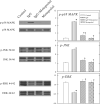Adoptive passive transfer of rabbit beta1-adrenoceptor peptide immune cardiomyopathy into the Rag2-/- mouse: participation of the ER stress
- PMID: 18155231
- PMCID: PMC2390583
- DOI: 10.1016/j.yjmcc.2007.11.007
Adoptive passive transfer of rabbit beta1-adrenoceptor peptide immune cardiomyopathy into the Rag2-/- mouse: participation of the ER stress
Abstract
Auto-antibodies against the beta(1)-adrenoceptors are present in 30-40% of patients with dilated cardiomyopathy. Recently, a synthetic peptide corresponding to a sequence of the second extracellular loop of the human beta(1)-adrenoceptor (beta(1)-EC(II)) has been shown to produce endoplasmic reticulum (ER) stress, myocyte apoptosis and cardiomyopathy in immunized rabbits. To study the direct cardiac effects of anti-beta(1)-EC(II) antibody in intact animals and if they are mediated via beta(1)-adrenoceptor stimulation, we administered IgG purified from beta(1)-EC(II)-immunized rabbits to recombination activating gene 2 knock-out (Rag2(-/-)) mice every 2 weeks with and without metoprolol treatment. Serial echocardiography and cardiac catheterization showed that beta(1)-EC(II) IgG reduced cardiac systolic function after 3 months. This was associated with increase in heart weight, myocyte apoptosis, activation of caspase-3, -9 and -12, and increased ER stress as evidenced by upregulation of GRP78 and CHOP and cleavage of ATF6. The Rag2(-/-) mice also exhibited increased phosphorylation of CaMKII and p38 MAPK. Metoprolol administration, which attenuated the phosphorylation of CaMKII and p38 MAPK, reduced the ER stress, caspase activation and cell death. Finally, we employed the small-interfering RNA technology to reduce caspase-12 in cultured rat cardiomyocytes. This reduced not only the increase of cleaved caspase-12 but also of the number of myocyte apoptosis produced by beta(1)-EC(II) IgG. Thus, we conclude that ER stress plays an important role in cell death and cardiac dysfunction in beta(1)-EC(II) IgG cardiomyopathy, and the effects of beta(1)-EC(II) IgG are mediated via the beta(1)-adrenergic receptor.
Figures








Similar articles
-
Cardiomyocyte apoptosis in autoimmune cardiomyopathy: mediated via endoplasmic reticulum stress and exaggerated by norepinephrine.Am J Physiol Heart Circ Physiol. 2007 Sep;293(3):H1636-45. doi: 10.1152/ajpheart.01377.2006. Epub 2007 Jun 1. Am J Physiol Heart Circ Physiol. 2007. PMID: 17545481
-
Pro-apoptotic effects of anti-beta1-adrenergic receptor antibodies in cultured rat cardiomyocytes: actions on endoplasmic reticulum and the prosurvival PI3K-Akt pathway.Autoimmunity. 2008 Sep;41(6):434-41. doi: 10.1080/08916930802031710. Autoimmunity. 2008. PMID: 18781469 Review.
-
Darbepoetin alfa exerts a cardioprotective effect in autoimmune cardiomyopathy via reduction of ER stress and activation of the PI3K/Akt and STAT3 pathways.J Mol Cell Cardiol. 2008 Aug;45(2):250-60. doi: 10.1016/j.yjmcc.2008.05.010. Epub 2008 May 27. J Mol Cell Cardiol. 2008. PMID: 18586265 Free PMC article.
-
Chronic Akt activation attenuated lipopolysaccharide-induced cardiac dysfunction via Akt/GSK3β-dependent inhibition of apoptosis and ER stress.Biochim Biophys Acta. 2013 Jun;1832(6):848-63. doi: 10.1016/j.bbadis.2013.02.023. Epub 2013 Mar 6. Biochim Biophys Acta. 2013. PMID: 23474308 Free PMC article.
-
The beta-adrenergic receptors.Herz. 2002 Nov;27(7):683-90. doi: 10.1007/s00059-002-2434-z. Herz. 2002. PMID: 12439640 Review.
Cited by
-
Autoimmunity in Cardiomyopathy-Induced Heart Failure and Cardiac Autoantibody Removal by Immunoadsorption.J Clin Med. 2025 Feb 1;14(3):947. doi: 10.3390/jcm14030947. J Clin Med. 2025. PMID: 39941618 Free PMC article. Review.
-
Hydrogen sulfide protects H9c2 cells against doxorubicin-induced cardiotoxicity through inhibition of endoplasmic reticulum stress.Mol Cell Biochem. 2012 Apr;363(1-2):419-26. doi: 10.1007/s11010-011-1194-6. Epub 2011 Dec 28. Mol Cell Biochem. 2012. PMID: 22203419
-
Receptor autoantibodies: Associations with cardiac markers, histology, and function in human non-ischaemic heart failure.ESC Heart Fail. 2023 Apr;10(2):1258-1269. doi: 10.1002/ehf2.14293. Epub 2023 Jan 30. ESC Heart Fail. 2023. PMID: 36717981 Free PMC article.
-
The unfolded protein response to endoplasmic reticulum stress in cultured astrocytes and rat brain during experimental diabetes.Neurochem Int. 2013 Apr;62(5):784-95. doi: 10.1016/j.neuint.2013.02.009. Epub 2013 Feb 11. Neurochem Int. 2013. PMID: 23411409 Free PMC article.
-
Diabetes- and angiotensin II-induced cardiac endoplasmic reticulum stress and cell death: metallothionein protection.J Cell Mol Med. 2009 Aug;13(8A):1499-512. doi: 10.1111/j.1582-4934.2009.00833.x. Epub 2009 Jul 6. J Cell Mol Med. 2009. PMID: 19583814 Free PMC article.
References
-
- Jahns R, Boivin V, Siegmund C, Inselmann G, Lohse MJ, Boege F. Autoantibodies activating human β1-adrenergic receptors are associated with reduced cardiac function in chronic heart failure. Circulation. 1999;99:649–54. - PubMed
-
- Iwata M, Yoshikawa T, Baba A, Anzai T, Mitamura H, Ogawa S. Autoantibodies against the second extracellular loop of beta1-adrenergic receptors predict ventricular tachycardia and sudden death in patients with idiopathic dilated cardiomyopathy. J Am Coll Cardiol. 2001;37:418–24. - PubMed
-
- Jahns R, Boivin V, Lohse MJ. β1-adrenergic receptor function, autoimmunity, and pathogenesis of dilated cardiomyopathy. Trends Cardiovasc Med. 2006;16:20–4. - PubMed
-
- Wallukat G, Wollenberger A, Morwinski R, Pitschner HF. Anti-β1-adrenoceptor autoantibodies with chronotropic activity from the serum of patients with dilated cardiomyopathy: mapping of epitopes in the first and second extracellular loops. J Mol Cell Cardiol. 1995;27:397–406. - PubMed
-
- Staudt A, Mobini R, Fu M, Große Y, Stangl V, Stangl K, et al. β1-adrenoceptor antibodies induce positive inotropic response in isolated cardiomyocytes. Eur J Pharmacol. 2001;423:115–9. - PubMed
Publication types
MeSH terms
Substances
Grants and funding
LinkOut - more resources
Full Text Sources
Other Literature Sources
Medical
Molecular Biology Databases
Research Materials
Miscellaneous

